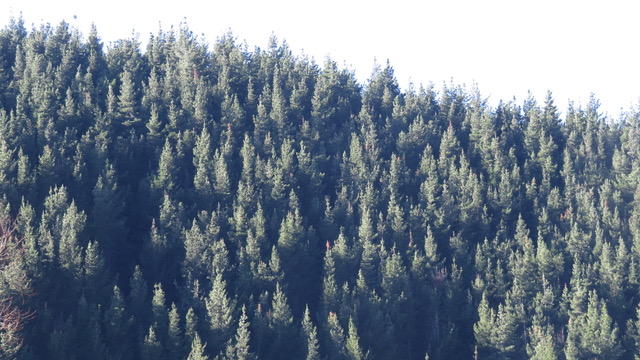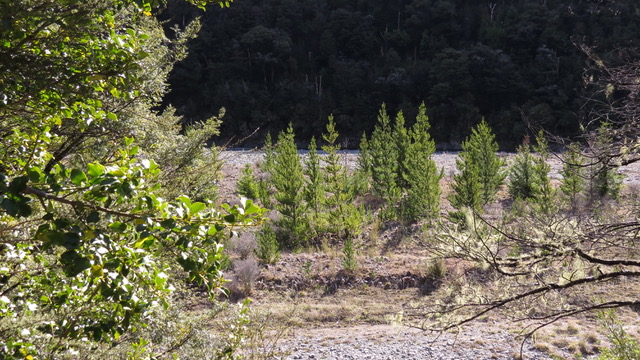Special Report
Some economists are wanting more commercial pine forests and more planting of pines for carbon credits.
And they are claiming that rivers and lakes would be cleaner if pines replaced livestock farming says a new paper from the “Our Land and Water” science challenge.
However the authors did raise the question as to whether New Zealanders want more pine trees. But money and profits are paramount. Four different research projects, using different models and involving different researchers, all pointed to New Zealand having more pine trees.
Good prices for carbon credits and current poor economics for sheep farming seemed to be a dual push for more pines.Dr Bill Kaye-Blake, a principal economist at economic consultants NZEI (NZ Institute of Economic Research).
Radio NZ quoted him as saying “The easiest solution is to plant a lot of pine trees. Now that’s probably not acceptable to a lot of people in New Zealand, to a lot of rural communities in New Zealand.”
Pine trees have a strong market for logs whereas the wool market is poor with it sometimes costing farmers to shear rather than get a return let alone break even. The studies showed New Zealand could have cleaner lakes, rivers and beaches, with more pine, he said.
The foresters argued water quality benefits of pines included lower nitrogen pollution and lower e-coli in the water.

The Marlborough Sounds is facing a crisis due to accelerated runoff and deposition of silt into its bays.
The environmental degradation and smothering of the inner marine ecosystems of the Sounds has occurred because of extensive planting in commercial exotic plantations in past decades and in recent years the harvesting practice clear felling of hillsides.
The ill effects are further upstream in the river valleys where freshwater aquatic ecosystems and trout fishing rivers suffer from siltation and forestry debris.
Yet the forest industry seems in denial. Back in December 2015 advertisement by New Zealand Wood extolled the environmental benefits of “plantation forestry” claiming they “stabilise hillsides, protect soil health, purify water, regulate its flow and help prevent flooding.”
Foreign Increase
How do the claims stack up? Well the term New Zealand Wood is a misnomer as New Zealand pine forests are largely foreign owned. In 2010 Keith Woodford Professor of Farm Management and Agribusiness Lincoln University wrote that about 72% of pine forests were foreign owned, with United States companies owning about 35% and Asian companies about 12%. More recent data is incomplete but foreign ownership appears to have further increased he added.
In 2023 the four largest private landowners in New Zealand were all foreign-owned forestry companies, an Radio NZ investigation found.
Despite a clampdown on some overseas investment, including a ban on residential sales to offshore buyers, the Ardern-led Labour government actively encouraged further foreign purchases of land for forestry through a “stream-lined special forestry test.
Since the 2021 election, the Overseas Investment Office (OIO) approved more than $2.3 billion of forestry-related land sales – about 31,000 hectares of it previously in New Zealand hands.
Environmentally, pine forests do stabilise hillsides at least for 25 years until clear felling at harvest time exposes whole catchments to any rains and subsequent runoff of silt and debris into streams, rivers and ultimately estuarine areas. But claims of enhancement of soil health, water purity and regulation of flow are all dubious.
In the UK information from studies in southwest Scotland point to a strong relationship between salmon fishery catch figures falling alarmingly since 1960 about the time pine forests were extensively planted.
More Acidity
Sources point to one detrimental aspect being acidification that occurs with monocultures of pines. The pH level (degree of acidity) is important to both bottom fauna and subsequently trout, juvenile salmon and native fish.
If the pH drops below 5.5 (increased acidity) then long term damage to the fishery, both native and trout, occurs.
The UK’s “Trout and Salmon” magazine said “conifers are highly efficient at taking and filtering acidity so that it flows through the soil and water beneath them. Thus acidic loading increases as the trees grow.”
Thirsty Pines
Pine forests do regulate water flow but in actual fact adversely by reducing normal natural water runoff that occurs with native vegetation. A pine tree is said to use 85 litres of water a day whereas a native tree, dependent on species, uses considerably less. Water from a pine forest with a “bare” pine needle forest floor has quicker runoff compared to a typical native forest area with shade-loving undergrowth. In a few words, native forest has a higher water retention factor leading to natural, more consistent stream flows.
Anecdotal evidence points to streams much reduced in flow once monocultures of pines have been established. For example, long-time residents in the Marlborough Sounds and the Northbank of the Wairau valley have observed the same diminished flow in creeks and streams after extensive monocultures of pine forests have been established.

Dry stream beds under the impact of a monoculture of pines, Northbank, Wairau Valley, Marlborough.
This stream was once a fully flowing all year round stream.
Adverse effects begin from day one when at planting time, native bush is usually cleared, often by burning.
In one case in Marlborough, a foreign-owned Malaysian corporate with extensive forest ownership throughout NZ, burned high country stations of native bush and bracken, roaded it in very steep country with slipping occurring into gullies and planted pines for carbon trading. Previously the original merino sheep stations had been “holistically” farmed with stable ecosystems.
Twenty five or thirty years at forest maturity and harvesting time, the practice of clear felling pines exposes often steep hill country to heavy rains and runoff of silt and debris. In some European countries, felling is in done in two cuts perhaps 12 months apart, along contours thus reducing runoff. The United States have enlightened forest felling regimes instead of total clear felling of hillsides.
One comment from a New Zealander who regularly visits the US – “I noticed when flying to Alaska each year is logging over Washington State and Oregon forests is clearly done on a patchwork quilt basis – not entire hillsides and mountains all planted at the same time and then logged at the same time.”
Clearly claims by the vested interest body Wood NZ are open to challenge. The conclusions are that required are:-
(a) Better zoning by councils to prevent forestry monocultures
(b) Better harvesting regimes as practised in Europe should be implemented
(c) Local council zoning of land should avoid extensive commercial forestry monocultures.
(d) Buffer zones of 50 metres of native vegetation along all streams
(e) Stricter rules to avoid planting on steep hillsides.
Rural communities suffer severe population declines as pines replace sheep and beef farms, which adversely impacts on infrastructure such as schools and other amenities.
Wilding pines become a problem with wind-blown seeding from plantation pines causing production and environmental problems respectively on farms and public conservation land.
Logging trucks adversely impact on rural roads.
The detrimental impact of pine forests on people, communities and the environment is considerable.

Wilding pines on public land seeded from commercial forestry

Clear Felling exposes soils to rains with heavily silt-laden runoff causing ecological damage
to coastal waters, rivers and streams. Pelorus Sound, Marlborough

This is very good. Too many economists can’t see the wood for the trees. The country should be run for the voting people not for a few vested interests of the foreign corporate kind
Most economists know the price of everything but the value of nothing. Cold cash counts. People don’t.
Pine monoculture is NOT the answer for the future of this country’s economy or its problems with freshwater quality or the massive amounts of methane produced by Fonterra, the country’s largest polluter of freshwater and the biggest greenhouse gas emitter.
That exotic timber is the best option for so much of our land is in itself an indictment – is that what we have been reduced to? Passive, foreign and mildly toxic to the land and local community. Now that I think about it, it’s actually emblematic of where NZ inc is at, maybe it is all we deserve.
Plant more trees as a cover/smoke-screen for continuing industries and practices that do the polluting? Industry needs to take a good look at itself and find ways to achieve reduction in the way they make or market their products. Not let someone else plant trees so they can sit smugly on their hands. But as always, follow the money trail.